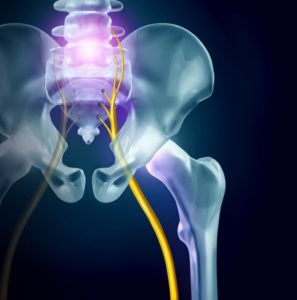
At the “cooler” at work, a co-worker complains of excruciating lower back pain that doesn’t seem to be going away. This pain sometimes even extends into the buttocks and legs sometimes, which means that the most likely culprit of their pain is sciatica.
You two seem to have similar enough lifestyles that you wonder whether you could be at risk of getting sciatica as well. What are the triggers for this lower back pain, and can it be avoided? Below are the risk factors for sciatica and how you can treat and prevent it from happening to you.
Prolonged Sitting
If you lead a sedentary lifestyle or have a job that involves sitting at a desk for several hours, you are at a higher risk of developing sciatica. Likewise, sitting or working out with improper posture can put pressure on this nerve, leading to immense pain.
A Weak Core
Unlike higher in the torso where the ribcage helps to support the spine, the lower back relies on your abdomen and low back muscles for stability. Those who do not keep these muscles engaged, toned, and active increase the strain on their lower backs and the sciatic nerve.
Overweight
The more weight you carry around with you, the harder your back and core muscles have to work to support. By keeping your weight under control, you can alleviate some of the load your lower back muscles have to bear.
Aging
As you age, the disks and bone tissues in your spine can start to wear down and slightly shift. As a result, the nerves connected to your lower back can become pinched or irritated.
Diabetes or Osteoarthritis
While their causes are different, these two conditions can impact the sciatic nerve. Those with diabetes often suffer nerve damage, including that of the sciatic nerve. Meanwhile, osteoarthritis may result in damage to the bones in the spine, increasing the likelihood of sciatica.
Pregnancy
Sciatica is a common symptom for pregnant women. During this time, the expecting mother’s body undergoes many changes, including the loosening of ligaments around the spine. Unfortunately, this allows the disks in the spine to slip and pinch nerves, and the baby’s weight and position can make the problem worse.
Treating Sciatica
Although sciatica may not always be preventable, there are things you can do to lessen the severity of your symptoms. In some cases, such as pregnancy, sciatica symptoms can subside on their own. However, in other cases, you can get more immediate relief with a chiropractor’s help and by being more healthy in your habits. Regular core exercise and good posture can go a long way to preventing this kind of pain as well.
Ultimately, if you meet any of the above criteria, your risk for sciatica increases. However, by making some small changes to your lifestyle, you can hopefully keep this condition from occurring.
About the Author
With more than 20 years of clinical experience, Dr. Zinovy Chukhman has received advanced training in most adjustment techniques, including Graston, Flexion-distraction, Gonstead, and Diversified. He has also completed all four parts of the National Board of chiropractic Examiners and BNCE Physical Rehabilitation certification. If you have questions about sciatica, you can contact him at AlignRight Chiropractic through the website.

 Follow
Follow